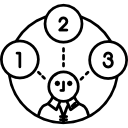Computational Thinking

Understandings[edit]
Computational thinking (abbreviated to CT) is an analytical process that can be broken down into four elements: Abstraction; Decomposition; Algorithms; and Pattern recognition.
Students must be able to explain (in the context of Computational thinking to analyse a given problem):
Computational thinking is essential for the development of computational solutions which may or may not be computer-based.
Students must be able to demonstrate:
- an approach to any given problem from a computational thinking point of view.
Computational thinking is a problem-solving process used across multiple disciplines, and not just in computer science.
Students must be able to apply:
- computational thinking to non-computer-based activities.
Computational thinking includes algorithmic thinking. Algorithmic thinking is the basis of solving problems through developing algorithms.
Students must be able to construct:
algorithms that address a given problem and evaluate whether a given algorithm would solve a given problem.